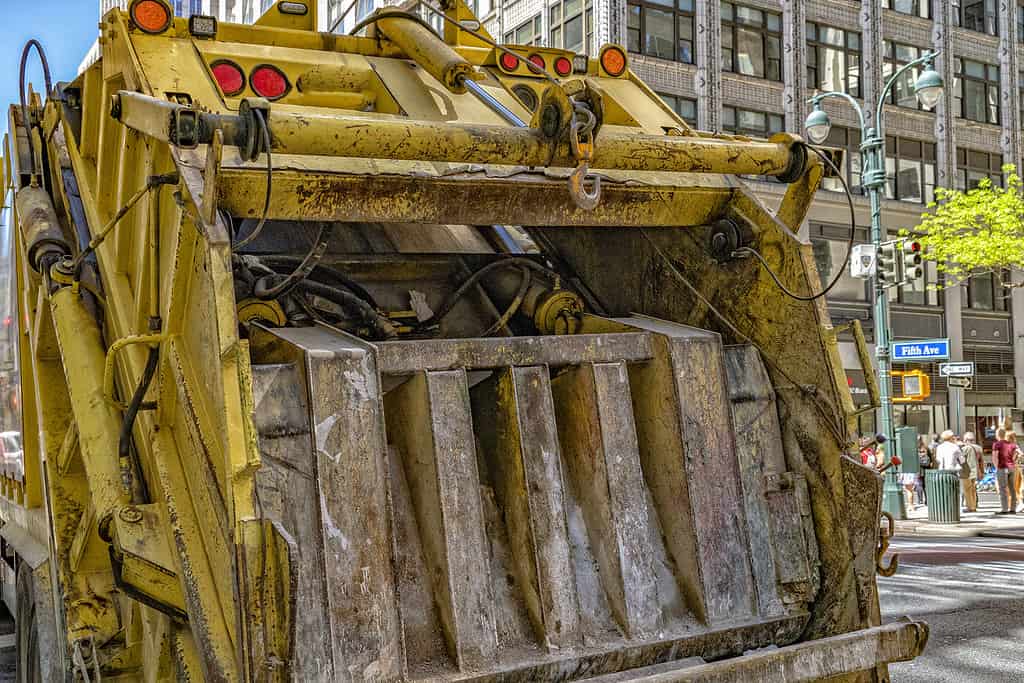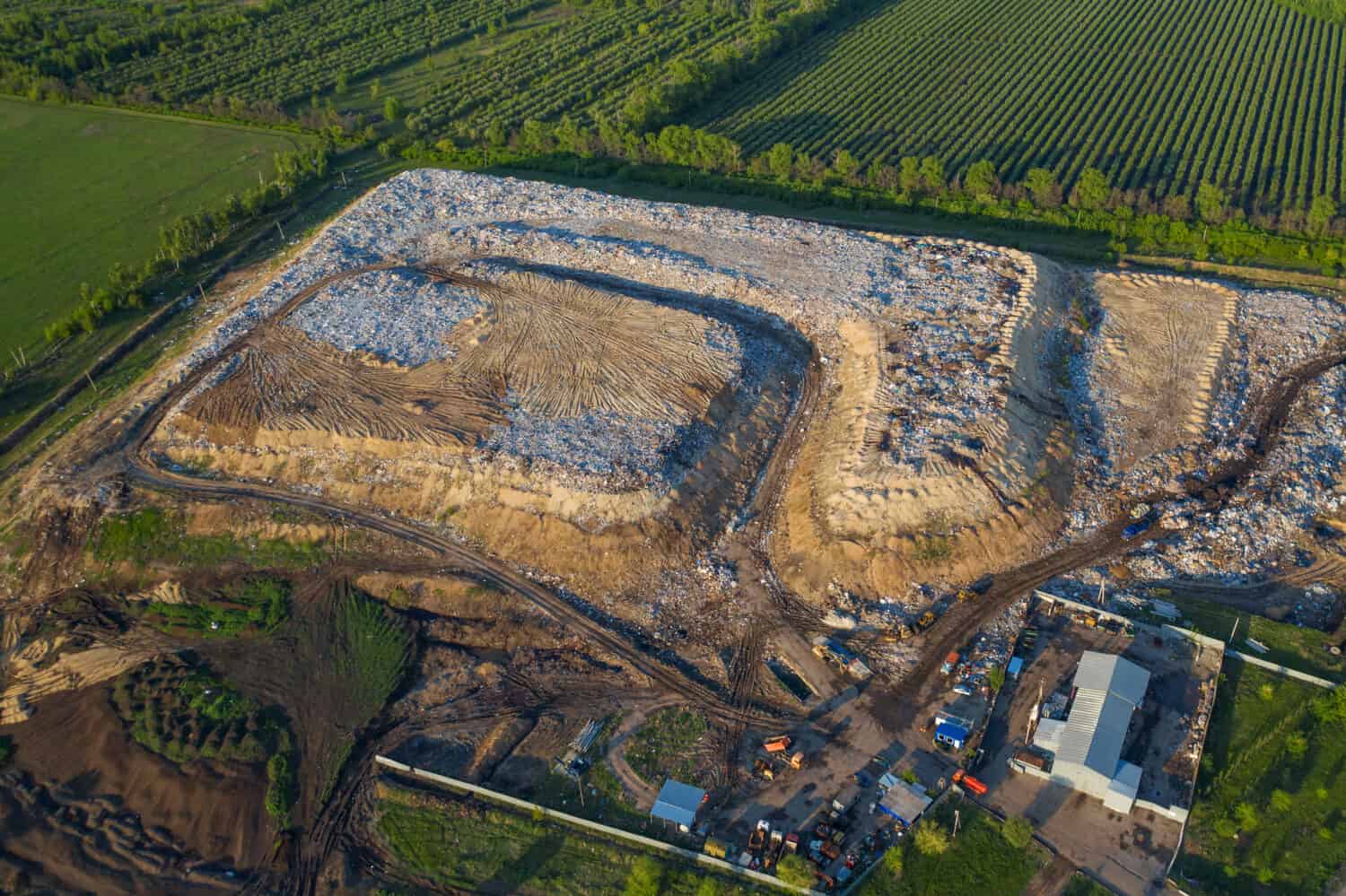
The landfill employs about 100 people, and landfill officials state officials it’s responsible for generating about $72 million for the local economy annually.
©izanbar/iStock via Getty Images
New York City is the most populous city in the United States. It is also the most densely populated major city with 8,804,190 people distributed over 300.46 square miles. The city helps New York State be the 27th largest state be the fourth most populous at around 19.51 million people. With all these people and not that much space, where does all the waste go? Luckily, the biggest landfill in New York is up to the challenge!
The Seneca Falls Landfill is the largest landfill in New York at almost 400 acres of landfill. A 2,600-acre facility sits on the grounds and is the fourth largest industrial employer in Seneca County. Despite its size, New York State still has trouble keeping up with the waste of its residents. Learn more about Seneca Falls Landfill and what steps it is taking toward sustainability. The future looks even bigger for the already large dumping grounds.
Where Is Seneca Falls Landfill On A Map?
The massive landfill sits near the Town of Waterloo in Seneca County in the western part of the state. This is the Finger Lakes Region. The county is bounded on the east by Cayuga Lake and on the west by Seneca Lake.
The landfill accepts trash from New York, Massachusetts, Connecticut, New Jersey, and Pennsylvania.
What Lives Near This Landfill?
Seneca Meadows imports garbage from at least 40 New York counties including New York City. It also takes trash from other New England states as well as Canada. In fact, less than 1% of the trash comes from the county it sits in! The town of Waterloo and Seneca County sits in the heart of the Finger Lakes. The landfill is located between the northernmost tips of Seneca and Cayuga Lakes.
Wildlife
The U.S. Fish & Wildlife Service manages 14 wildlife refuges in New York State. Of these, Montezuma National Wildlife Refuge in the Finger Lakes provides a feeding and nesting habitat for more than 300 species of birds including waterfowl, marsh birds, shorebirds, raptors, warblers, woodpeckers, and bald eagles. The 10,000-acre refuge sits at the north end of Cayuga Lake in the Finger Lakes Region of New York State.
Wetlands Preserve
The Seneca Meadows Landfill features 576 acres of wetlands. In 2007, they created 419 acres of new wetlands and restored 157 acres of existing wooded wetlands. Landfills have an industry to mitigate the loss of wetland habitat in the creation of the landfill. The standard is a 3:1 exchange ratio. Seneca Meadows designated eight times the taken acreage for the landfill for permanent conservation.
The preserve offers over seven miles of hiking trails as well. The trails travel through various landscapes including forested land, lush prairies, and several serene ponds. They are open year-round from dawn to dusk, and completely free to explore.
Finger Lakes

Seneca Lake is the deepest lake entirely within the state.
©PQK/Shutterstock.com
The Finger Lakes by the landfill include Seneca and Cayuga. The Finger Lakes are a group of 11 long, narrow lakes located directly south of Lake Ontario.
Seneca Lake lies in the geographic center of the Finger Lakes and has the largest volume of water. It is 38 miles long and 43,343 acres. There are various fish species in the lake including bluegill, trout, pike, bass, perch, and even Atlantic salmon. Cayuga Lake ranks second in size behind Seneca. It also offers a diverse fishery for both coldwater and warmwater species due to its shallow weedy area at the north end while the remainder of the lake is deep and supports a coldwater trout and salmon fishery. The lake is 38 miles long as well and 42,956 acres. The lake has become a favorite stop for professional largemouth bass fishing and tournaments.
Wineries
The area is also surrounded by the largest concentration of wineries in the region. There are wineries a mere 10 miles from the landfill. The area depends on flourishing tourism as visitors can sip their way through two official wine trails – Seneca Lake Wine Trail and America’s first wine trail, Cayuga Lake Wine Trail. There are also microbreweries, a distillery, a meadery, and cidery options. Visitors have to compete with the 75 tractor-trailers filled with trash that drop off 6,000 tons of garbage each day, six days a week.
How Many Landfills Are In New York?

All of the active landfills are located in Upstate New York.
©DedMityay/Shutterstock.com
Currently, there are 25 active Municipal Solid Waste Landfills (MSW) in New York State. Municipal solid waste is just a fancy phrase for trash. So, these landfills consist of everyday items discarded by the public. The different landfills accept residential, commercial, and institutional wastes. The landfills consist of 11 active Construction and Demolition Debris Landfills, 5 Long Island Landfills operating in Nassau and Suffolk Counties, and 9 Industrial Waste Landfills.
All the landfills are designed with an environmental containment system. This includes a final cover system and a double composite liner system. The minimum liner required for an MSW landfill is a double composite liner. They protect the environment from contaminants. The landfills also contain on-site environmental monitoring systems. They monitor for any sign of groundwater contamination and landfill gas. The lining system protects the soil and groundwater. It isolates the landfill contents from the environment and drains leachate to collection and treatment facilities.
What Risks Does Seneca Meadows Present To New York?

Just a small percentage of the trash in the landfill is local. About a third of it comes from New York City.
©Nico.Stock/Shutterstock.com
While landfills are monitored by the government, and made to comply with federal rules and regulations, they are not necessarily environmentally friendly.
All landfills straddle the line of managing human waste and preserving environmental integrity. Health concerns and environmental concerns such as potential leakage of toxins into groundwater, air pollution, odors, and the effects on local wildlife are all valid! Even the noise, odors, and increased traffic from garbage trucks are a disturbance to the surrounding communities.
Toxic Gases
The emission of methane gas from landfills is the primary environmental issue. Methane gas is generated during the breakdown of organic material in landfills. It is among the most powerful greenhouse gases. Research shows methane to be a major cause of climate change considering it is 84 times stronger than carbon dioxide at capturing heat from the sun.
In addition to methane, landfills also release water vapor, carbon dioxide, and a small quantity of oxygen, nitrogen, and other non-methane organic molecules. If not under control, these gases can play a role in climate change and lead to pollution.
Destroying Nature
In general, the construction of landfills results in the destruction of wildlife’s surroundings. A landfill typically covers 600 acres. There are currently over 3,000 operational landfills in the US, which has resulted in the loss of up to 1,800,000 acres of habitat.
Federal law mandates that landfills have a synthetic or clay lining, yet these liners frequently leak. As a result, neighboring water sources may become contaminated with leachate, a liquid generated by landfills, which further harms ecosystems.
Ammonia concentrations in leachate can be very high. Ammonia is nitrified to form nitrate when it enters ecosystems. Eutrophication, or a shortage of oxygen as a result of enhanced growth of plants, might then result from this nitrate in neighboring water sources.
Harming Humans
People who live and work close to landfills are at risk for health problems because of waste emissions. According to a study in New York State, there is a 12% higher chance of congenital abnormalities in babies born to families that live less than one mile from a toxic waste landfill. Landfills and dangerous waste dumps have a greater probability of being located in minority and low-income regions.
Landfills also bring hazards such as odor, smoke, noise, bugs, and water supply contamination to those around them. The New York Department of Health saw an increase in lung cancer in northern Seneca County over a five-year span. From 2016 to 2020, lung cancer cases in Seneca County were 31% above the state average and 34% above the national average, according to the National Cancer Institute.
Who Owns The Landfills In New York?
The private sector owns some of the landfills in New York. Waste Connections, a private company, owns and operates Seneca Meadows. Another privately owned landfill is High Acres Landfill, owned and operated by Waste Management.
However, in the United States, most landfills are regulated by the Environmental Protection Agency (EPA) and the state’s environmental agencies. New York State is no different with most of their landfills owned by government or state agencies.
Conclusion
Though landfills are deemed necessary, they aren’t always welcome. Seneca Medows is no different. The owner wants to expand, and the town wants to shut it down. There are supporters on both sides and at the moment, the landfill’s future is unclear.
There are upcoming hearings before state regulators, and an environmental impact study must be finalized. But as of today, trucks are still taking the trash to the landfill from all over the state.
The photo featured at the top of this post is © IM_photo/Shutterstock.com
Thank you for reading! Have some feedback for us? Contact the AZ Animals editorial team.






